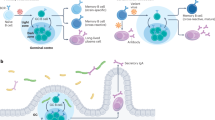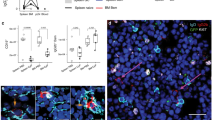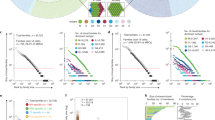B–cell memory is short-lived in the absence of antigen (original) (raw)
- Letter
- Published: 03 November 1988
Nature volume 336, pages 70–73 (1988)Cite this article
- 645 Accesses
- 393 Citations
- 1 Altmetric
- Metrics details
Abstract
Primary encounter with antigen stimulates specific B cells not only to differentiate into cells that produce antibody at a high rate (plasma cells), but also to give rise to populations of memory cells. These cells have many characteristics that differ from virgin B cells, including their lifespan1. When re-exposed to antigen, memory cells generate secondary IgG responses that are enhanced in rate, titre and affinity. At present they are considered as small resting lymphocytes which survive for long periods in a quiescent state between each antigen encounter2. However, the fact that an individual may continue to make an antibody response for many months following a single injection of antigen3,4 is often overlooked. This continued antibody production is probably due to repeated stimulation of antigen-specific B cells and raises the question of whether memory B-cell clones require antigen for their maintenance. Here we show that they do, and that following transfer, in the absence of antigen, memory B-cell populations are lost from the adoptive host after 10–12 weeks.
This is a preview of subscription content, access via your institution
Access options
Subscribe to this journal
Receive 51 print issues and online access
$199.00 per year
only $3.90 per issue
Buy this article
- Purchase on SpringerLink
- Instant access to full article PDF
Prices may be subject to local taxes which are calculated during checkout
Additional access options:
Similar content being viewed by others

Memory B cells
Article 03 July 2023


References
- Strober, S. Transplant Rev. 24, 84–112 (1975).
CAS PubMed Google Scholar - Hood, L. E., Weissman, I. L., Woods, W. B. & Wilson, J. H. in Immunology, 2nd edn, 11 (Benjamin/Cummings, Melo Park, California, 1984).
Google Scholar - Gray, D., MacLennan, I. C. M. & Lane, P. J. L. Eur. J. Immun. 16, 641–648 (1986).
Article CAS Google Scholar - Tew, J. G., Phipps, R. P. & Mandel, T. E. Immunol. Rev. 53, 175–201 (1980).
Article CAS Google Scholar - MacLennan, I. C. M. & Gray, D. Immunol. Rev. 91, 63–85 (1986).
Article Google Scholar - Askonas, B. A. & Williamson, A. R. Eur. J. Immun. 2, 487–493 (1972).
Article CAS Google Scholar - Lane, P. J. L., Gray, D., Oldfield, S. & MacLennan, I. C. M. Eur. J. Immun. 16, 1569–1575 (1986).
Article CAS Google Scholar - Gray, D. Immunology 65, 73–79 (1988).
CAS PubMed PubMed Central Google Scholar - Gray, D. J. exp. Med. 167, 805–816 (1988).
Article CAS Google Scholar - Askonas, B. A., Cunningham, A. J., Kreth, H. W., Roelants, G. E. & Williamson, A. R. Eur. J. Immun. 2, 494–498 (1972).
Article CAS Google Scholar - Feldbush, T. L. Cell Immun. 8, 435–444 (1973).
Article CAS Google Scholar - Celada, F. J. exp. Med. 125, 199–211 (1967).
Article CAS Google Scholar - Mandel, T. E., Phipps, R. P., Abbot, A. & Tew, J. G. Immunol. Rev. 53, 29–57 (1980).
Article CAS Google Scholar - Tew, J. G. & Mandel, T. E. J. Immun. 120, 1063–1069 (1978).
CAS PubMed Google Scholar - Tew, J. G. & Mandel, T. E. Immunology 37, 69–76 (1979).
CAS PubMed PubMed Central Google Scholar - Mims, C. A. Pathogenesis of Infectious Disease 3rd edn, 132 (Academic, London, 1987).
Google Scholar - Frankel, L. D. & Bellanti, J. A. in The Immunology of Human Infection Part II (eds Nahamias, A. J. & O'Reilly, R. J.) 135 (Plenum, London, New York, 1982).
Book Google Scholar - Black, S. J., Tokuhisa, T., Herzenberg, L. A. & Herzenberg, L. A. Eur. J. Immun. 10, 846–851 (1980).
Article CAS Google Scholar - Zan-Bar, I., Strober, S. & Vitetta, E. S. J. Immun. 123, 925–930 (1979).
CAS PubMed Google Scholar - Hayakawa, K., Ishii, R., Yamasaki, K., Kishimoto, T. & Hardy, R. R. Proc. natn. Acad. Sci. U.S.A. 84, 1379–1383 (1987).
Article ADS CAS Google Scholar - Lui, Y.-J., Oldfield, S. & MacLennan, I. C. M. Eur. J. Immun. 18, 355–362 (1988).
Article Google Scholar - Kumararatne, D. S. & MacLennan, I. C. M. Eur. J. Immun. 11, 865–869 (1981).
Article CAS Google Scholar - Ron, Y. & Sprent, J. J. Immun. 138, 2848–2856 (1987).
CAS PubMed Google Scholar - Hunt, S. V. & Fowler, M. H. Cell Tissue Kinet. 14, 445–464 (1981).
CAS PubMed Google Scholar - Gray, D., Chassoux, D., MacLennan, I. C. M. & Bazin, H. Clin. exp. Immun. 60, 78–86 (1985).
CAS PubMed Google Scholar - Mäkelä, O., Kaartinen, M., Pelkonen, J. L. T. & Karjalainen, K. J. exp. Med. 148, 1644–1660 (1978).
Article Google Scholar - Williams, A. F., Galfré, G. & Milstein, C. Cell 12, 663–637 (1977).
Article CAS Google Scholar - Dallman, M. J., Mason, D. W. & Webb, M. Eur. J. Immun. 12, 511–518 (1982).
Article CAS Google Scholar
Author information
Authors and Affiliations
- Basel Institute for Immunology, Grenzacherstrasse 487, Postfach CH-4005, Basel, Switzerland
David Gray & Helena Skarvall
Authors
- David Gray
You can also search for this author inPubMed Google Scholar - Helena Skarvall
You can also search for this author inPubMed Google Scholar
Rights and permissions
About this article
Cite this article
Gray, D., Skarvall, H. B–cell memory is short-lived in the absence of antigen.Nature 336, 70–73 (1988). https://doi.org/10.1038/336070a0
- Received: 27 May 1988
- Accepted: 30 September 1988
- Issue Date: 03 November 1988
- DOI: https://doi.org/10.1038/336070a0